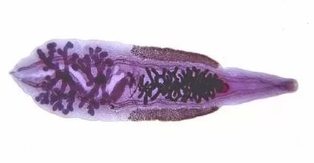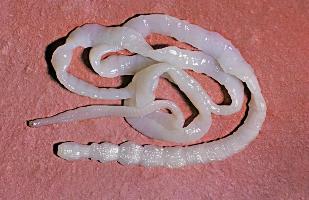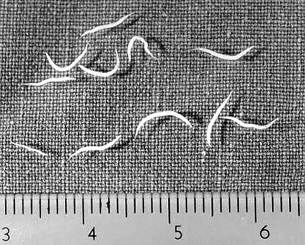
Helminthiases is one of the most common diseases in children and adults. The human body can parasitize a variety of species of worms. It is considered a far from medicine, in which the worms affect the digestive tract and, in fact, worms can parasitize virtually all of the internal organs – the liver, the lung, the heart, the brain, the head and the muscle tissue, subcutaneous tissue, and eyes. The article talks about how you have to the people.
The classification of the
There are a large number of worms which can affect humans, some of the most common of them. Most of the worms belonging to any of the 3 groups, trematodes, cestodes, or nematodes.
Flukes are a class of parasitic worms, the flat shapes, there are about 40 species of worms that affect humans. The most common:
- a cat or Siberian Fluke (causes opisthorchiasis);
- Schistosoma (causing schistosomiasis).
Cestodes-tape worms, it is just. The representatives of the cestodes is the digestive system. Most of the man are staggering:
- beef tapeworm (beef tapeworm infection causes);
- pork tapeworm (causing cysticercosis);
- Echinococcus (hydatid cyst causes).
In the Nematoda the roundworms, which is mainly in the abdomen. Common helminth affecting people.
- pinworms;
- roundworm;
- the whipworm.
You have the people and the characters in the picture (the majority of the worms affect the digestive tract, therefore, nausea and vomiting, diarrhea or constipation, intestinal obstruction, unexplained weight loss, lack of appetite or excessive hunger):
A cat or Siberian Fluke

A cat or Siberian Fluke – a small parasite lanceolate, from a group of liver flukes. The causative agent of the disease opisthorchiasis. The length of the cat-Fluke reaches 8-18 mm in width and 1.2-2 mm. The parasite develops in the body of the two hosts, both intermediate and final. The intermediate hosts – molluscs and fish, the carp, the back of the man.
Along with the faeces of infected humans or animals, the eggs get into fresh water reservoirs, where they eat the shellfish. In the body of a mollusk eggs to reach the infective stage – cercaria, cercaria leave the mollusk and implanted in the body of a cyprinid fish, whether it is in or on your body with the consumption of fish and shellfish. In the body of a fish the parasite develops in the meta-cercaria in the cyst is and its size, it reaches about 0.17-0.21 mm).
When they eat contaminated fish, the infected people, the body of the meta-cercaria leave the cyst from the stomach and intestine, which are passed on to the liver and the bile ducts. In these organs they are still a parasite, and 10 to 12 days to reach the Mature stage, they begin to lay eggs. In the human body of a cat-Fluke, you can parasitize up to 10 to 20 years of age.
Shistosoma
Schistosoma-blood flukes. This is exactly the dioecious helminths, has a length of 4-20 mm in width – 0.25 mm. The body of a shistosoma is equipped with 2 suckers – oral and ventral, are situated close to each other. The woman in the Schistosoma is longer and thinner than the males. In the body of a man, with the longitudinal groove has a female. The balls of 0.1 mm in diameter, oval-shaped, on the surface of one of the poles is a great tip.
Human worms Schistosoma in the application of the final to the host selected by the people in their organisms they parasitize in the small vessels of the large intestine, abdominal cavity, uterus, bladder. The worms feed on the blood of the partially absorbing the nutrients through cuticle. Eggs of Schistosoma are transported into the intestine and the bladder, which Mature and are excreted with the feces or urine. In fresh water the egg comes out the larva, the intermediate hosts – mollusks. In the body of a mollusk meta-cercaria cercaria develop to the 4-to 8-week period.
Beef tapeworm

Beef tapeworm – the parasite that causes the disease in beef tapeworm infection. This is important helminths are able to grow to 3-12 m in length. In the body of the parasite, a small head, with a diameter of 3 mm, the neck, and about 1000 segments. According to the time of entry into the human body, along with the unprocessed infected meat, the tapeworm attaches to the intestinal wall with the help of 4 suction cups.
In the hermaphroditic segments, which are deposited eggs of the helminth, and every year, one person provides up to 600 million eggs. As the worms in humans, parasitic in the intestine of 20 years or more, if not timely medical treatment.
Pork tapeworm
Pork tapeworm as a bull and the body is it has 4 of the suckers in addition to this, the body of the helminth has a double rim hook. It reaches two to three meters in length. They have a pork tapeworm before the ovaries to each side of the uterus, 7 and 12 of the branches. A typical helminth – ability of the segments to crawl out of the anus. After the release of her shell, becoming the dry and burst, so the external environment are helminth eggs. The intermediate host of the tapeworm can be pigs, and humans.
The main host was a man. Intestinal parasites in humans include the pork tapeworm, is a helminth in the intestine of the patient, where this is provided for in its time. The infection occurs in the use of the invasive meat.
Echinococcus
The causative agent of echinococcosis in length, it reaches 3-5 mm). Consists of the head has four suckers, and two of the wheels of the hook; and the three or four segments. The last segment of the developed reproductive system. The intermediate host – cattle or people, the final host – dog, wolf. The infection occurs by the oral route.
Echinococcus enters the intestines, where the eggs emerge the larvae. With the help of the hooks of the larvae to penetrate into the portal vein, which, together with the blood spread to the liver, lungs, muscles, and tissues.
Pinworms

Pinworms – roundworms, enterobiasis causes of the disease, the so-called diseases of dirty hands. To a greater extent, the pinworm infection-prone children. Infection occurs orally, and turn it into a household. The discovery of these worms in the stool.
The helminths pinworms of the genus reach a length of 5 to 10 mm, males grow up to 3 mm. The shape of the body are pinworms fusiform milky white. At the end of the body of the female is slightly pointed. The adult worms are parasitic in the lower small intestine and the large intestine of man, who is attached to the wall by the head of the vesicles. To lay eggs, the female pinworms pass to the rectum, crawl out and lay eggs in the anal area, and then he died. Its eggs become infective after 4-6 hours. The duration of the pinworm life of one to two months.
Roundworm
Roundworm – in addition, some of the representatives of the class of roundworms parasites, the causative factors of ascariasis. This is the helminths of yellow – pink colour, have an elongated, spindle-shaped, dioecious. Female ascarids grow up to 20-40 cm and males reaching a length of 15-25 cm. Each day, an adult female roundworm lays down a more than 200-thousand eggs, which, together with the secretions of a person, that is released into the environment, where it is around 12-14 days to become invasive.
In the human body parasites in the digestive system, localizes mainly in the small intestine. The complete cycle of development from the infective eggs to Mature stage takes about 3 months.
Whipworm
Whipworm – the circle of fire, which is caused by trihozefalez. You have to have a thin brown nematode with a very thin, threadlike anterior portion and a rounded posterior end. A female whipworm can grow, and 3.5-5.5 inches, and males grow up to 3-4,5 cm. The larvae of the worms, the human, are localized in the caecum, where they are parasitic in the stage of puberty, she has to lay its eggs. The great invasion of helminths can also take the colon, including the rectum.
Every day, the female whipworm lays down to 3,5 thousands of eggs. Helminth eggs have a barrel shape, covered with a thick brown shell, the poles of which are located in the "caps". The eggs are in the soil along with the faeces of the primary host, under favorable conditions, they can retain the invasive properties of up to two years of age. The duration of parasitism in the human intestine is 5-7 years of age.






































